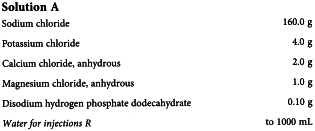Appendix XIV G. Test for Histamine
Euthanise a guinea-pig weighing 250 g to 350 g that has been deprived of food for the preceding 24 h. Remove a portion of the distal small intestine 2 cm in length and empty the isolated part by rinsing carefully with solution B described below using a syringe. Attach a fine thread to each end and make a small transverse incision in the middle of the piece of intestine. Place it in an organ bath with a capacity of 10 mL to 20 mL, containing solution B maintained at a constant temperature (34 °C to 36 °C) and pass through the solution a current of a mixture of 95 parts of oxygen and 5 parts of carbon dioxide. Attach one of the threads near to the bottom of the organ bath. Attach the other thread to an isotonic myograph and record the contractions of the organ on a kymograph or other suitable means of giving a permanent record. If a lever is used, its length is such that the movements of the organ are amplified about 20 times. The tension on the intestine should be about 9.8 mN (1 g) and it should be adjusted to the sensitivity of the organ. Flush out the organ bath with solution B. Allow it to stand for 10 min. Flush 2 or 3 times more with solution B. Stimulate a series of contractions by the addition of measured volumes between 0.2 mL and 0.5 mL of a solution of histamine dihydrochloride R having a strength which produces reproducible submaximal responses. This dose is termed the “high dose”. Flush the organ bath (preferably by overflow without emptying the bath) 3 times with solution B before each addition of histamine. The successive additions should be made at regular intervals allowing a complete relaxation between additions (about 2 min). Add equal volumes of a weaker dilution of histamine dihydrochloride R which produces reproducible responses approximately half as great as the “high dose”. This dose is termed the “low dose”. Continue the regular additions of “high” and “low” doses of histamine solution as indicated above, and alternate each addition with an equal volume of a dilution of the solution to be examined, adjusting the dilution so that the contraction of the intestine, if any, is smaller than that due to the “high dose” of histamine. Determine whether the contraction, if any, is reproducible and that the responses to the “high” and “low” doses of histamine are unchanged. Calculate the activity of the substance to be examined in terms of its equivalent in micrograms of histamine base from the dilution determined as above.
The quantity so determined does not exceed the quantity prescribed in the monograph.
If the solution to be examined does not produce a contraction, prepare a fresh solution adding a quantity of histamine corresponding to the maximum tolerated in the monograph and note whether the contractions produced by the preparation with the added histamine correspond to the amount of histamine added. If this is not the case, or if the contractions caused by the substance to be examined are not reproducible or if subsequent responses to “high” and “low” doses of histamine are diminished, the results of the tests are invalid and the test for depressor substances (2.6.11) must be carried out.
Solution B should be freshly prepared and used within 24 h.

